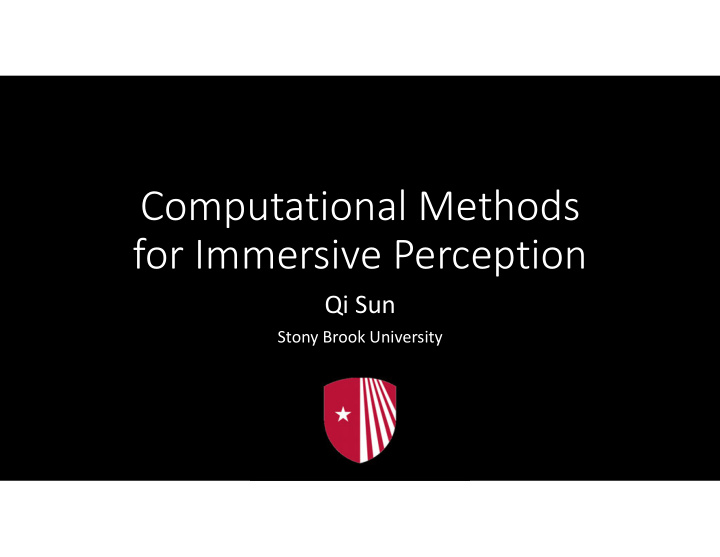



Computational Methods for Immersive Perception Qi Sun Stony Brook University
Warehouse/Arts District, New Orleans, USA
Traditional Visual Media
Immersive Visual Media
Perception for Better Immersive Experience Where we are? What we see? Miquel Perello Nieto
Where we are?
Nobel Brain Study
Locomotion System in the Brain
Locomotion System in the Brain
VR Locomotion: Gadgets Un‐natural Portable
VR Locomotion: Walk‐in‐Place Natural? Bulky
Free Locomotion Natural Limited space Portable
Constraint: Spatial Mismatching Virtual World Real Space https://vid.me/gTuI
Redirected Walking
Inception
Challenges
• Match large virtual and small real spaces • Users move with comfort and safety • Accurate locomotion and visual fidelity Mapping Virtual and Physical Reality Qi Sun , Li‐Yi Wei, Arie Kaufman, SIGGRAPH 2016
Automatic Content Re‐Creation
virtual floor plan HMD view physical floor plan Mapping Virtual and Physical Reality Qi Sun , Li‐Yi Wei, Arie Kaufman, SIGGRAPH 2016
Angle Preserving min (| ‐ |) β α
Local Distance Preserving
Geometric Preserving Visualization
Boundary Mapping Virtual and Physical Reality Qi Sun , Li‐Yi Wei, Arie Kaufman, SIGGRAPH 2016
Interior Obstacles Mapping Virtual and Physical Reality Qi Sun , Li‐Yi Wei, Arie Kaufman, SIGGRAPH 2016
Blended Rendering Motion High λ 1 λ 2 + = sickness! distortion! Warped Original
Different Weights
Different Weights
Different Weights
Different Weights
Where we are • Manipulate visual stimuli for spatial matching • Extend image‐based modulations to immersive worlds Content‐aware media re‐creation
What we see?
Depth Cue from Accommodation Accommodation Photo credit: Fu‐Chung Huang
Traditional Displays
Critical to Immersive Media • Vergence–Accommodation Conflict ‐> Sickness
Critical to Immersive Media • Vergence–Accommodation Conflict ‐> Sickness • Depth Understanding, esp. AR/MR
Wide Field Of View Varifocal Near‐eye Display Using See‐through Deformable Membrane Mirrors, Dunn et al. 2017
Critical to Immersive Media • Vergence–Accommodation Conflict ‐> Sickness • Depth Understanding, esp. AR/MR • Interaction Accuracy
Traditional Displays
Light Field Displays
Perceptually‐Guided Foveation for Light Field Displays Qi Sun et al., SIGGRAPH Asia 2017
Light Field Displays Light Field Displays Perceptually‐Guided Foveation for Light Field Displays Qi Sun et al., SIGGRAPH Asia 2017
Light Field Displays Perceptually‐Guided Foveation for Light Field Displays Qi Sun et al., SIGGRAPH Asia 2017
Light Field Displays Perceptually‐Guided Foveation for Light Field Displays Qi Sun et al., SIGGRAPH Asia 2017
Light Field Displays Perceptually‐Guided Foveation for Light Field Displays Qi Sun et al., SIGGRAPH Asia 2017
The light field stereoscope, Huang et al. SIGGRAPH 2015
high latency → AR/VR sickness
Foveated Human Vision Cone Fovea Cells
Perceptually‐Based Foveated Virtual Reality, Patney et al. 2016
Foveated Light Fields Perceptually‐Guided Foveation for Light Field Displays Qi Sun et al., SIGGRAPH Asia 2017
? ? Focusing Plane Display DoF LF Display � � A B spatial � � � bandwidth � Receptor Field ���� � (a) eccentricity
Psychophysical Studies – Blur Stimuli Depth Depth Diff Blur Diff Discrimination Detection Detection are they different? which is closer? are they different?
Perceptual Studies for Foveated Light Field Displays Joohwan Kim et al., arXiv 2017
Psychophysical Studies – Light Field Stimuli Depth Depth Diff Blur Diff Discrimination Detection Detection are they different? which is closer? are they different?
Perceptual Studies for Foveated Light Field Displays Joohwan Kim, et al. arXiv 2017
Angular Spatial
Perceptually‐Guided Foveation for Light Field Displays Qi Sun et al., SIGGRAPH Asia 2017
foveated light field full light field
Ours Full resolution [Huang et al. 2015] FPS 60 50 49.2 48 46.5 44.4 40 33.5 32 30 29.9 29.8 20 15.7 15.4 15.1 15 10 0 Scene 1 Scene 2 Scene 3 Scene 4
What we see • Track, understand, analyzing the anatomical eyes Faster, more comfortable, natural Content representation/authorization/viewing
What’s Next?
Eye‐Tracked Immersive Perception • Foveal VS peripheral vision • Perception of dynamics • (Large) Immersive media interface Why Important? • Cinematography • Other actions • Vergence • Blink http://bair.berkeley.edu/blog/2017/11/09/learn‐to‐attend‐fovea/ Panning and Zooming High‐Resolution Panoramas in Virtual Reality, Chang and Cohen, UIST 2017
Perception‐assisted Immersive Creation • Immersive media editing • Painting/Sculpting • Light Field Capturing • Collaborative authorization Vremiere: In‐headset Virtual Reality Video Editing, Nguyen et al., CHI 2017 CollaVR: Collaborative In‐Headset Review for VR Video, Nguyen et al., UIST 2017
Thank You! & Discussion More Materials: http://qisun.me/ Major References: • Mapping Virtual and Physical Reality. Qi Sun , Li‐Yi Wei, and Arie Kaufman, SIGGRAPH 2016 • Perceptually‐Guided Foveation for Light Field Displays. Qi Sun , Fu‐Chung Huang, Joohwan Kim, Li‐Yi Wei, David Luebke, and Arie Kaufman, SIGGRAPH Asia 2017
Recommend
More recommend